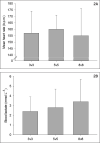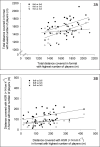Internal and external load during 8 v 8, 5 v 5 and 3 v 3 in Chinese elite youth male football players
- PMID: 36247968
- PMCID: PMC9536380
- DOI: 10.5114/biolsport.2022.113292
Internal and external load during 8 v 8, 5 v 5 and 3 v 3 in Chinese elite youth male football players
Abstract
Aim to investigate internal and external load in three different game formats (8 v 8, 5 v 5, 3 v 3 with 80 m2 per player) of small-sided games (SSG) in Chinese elite youth football players. Twenty-nine elite male football players (age: 18.3 ± 0.5 years (mean ± SD), height: 175 ± 6 cm, weight: 65.5 ± 6.3 kg) participated in randomized order in the three formats. Each session consisted of 20 min: 3 v 3 on a 24 × 20-m pitch, 5 v 5 on a 32 × 25-m pitch, or 8 v 8 on a 40 × 32-m pitch all equalling 80 m2 per player. Each player was recorded once in each format. Using GPS-units and heart rate belts and blood lactate measured the two kinds of load. 8-10% higher total distance (P < 0.01) was observed in 8 v 8 and 5 v 5 compared with 3 v 3 (1627 ± 240 and 1595 ± 243 m vs. 1477 ± 179 m, ES = 0.55-0.71). Higher distance (P < 0.001) was covered with high speed running (HSR: > 14 km/h) in 8 v 8 and 5 v 5 than 3 v 3 (154 ± 94 m and 133 ± 59 m vs. 77 ± 35, ES = 1.09-1.15), whereas very high speed running distance (> 21 km/h) was higher (P < 0.01) in 8 v 8 than 5 v 5 and 3 v 3 (15.2 ± 19.5 vs. 5.3 ± 6.7 and 1.0 ± 0.4 m, ES = 0.69-1.03) and in 5 v 5 than 3 v 3. No difference was found between game formats in the number of intense accelerations nor intense decelerations. Blood lactate (3.5 ± 2.3 vs. 2.8 ± 1.9 vs. 2.4 ± 1.5 mmol · L-1, P = 0.201) and mean heart rate (155 ± 21 vs. 160 ± 11 vs. 157 ± 17 bpm, P = 0.254) was not different between 8v8, 5v5 and 3v3 game formats. Distance covered in total and in highest speed zones was higher in SSG formats with more players, which, however, did not lead to differences in internal load measured by heart rate and blood lactate.
Keywords: Blood lactate; GPS; Game formats; High-intensity running; Small-sided games; Sprints.
Copyright © Biology of Sport 2022.
Conflict of interest statement
The authors declared no conflict of interest.
Figures



Similar articles
-
Relative pitch area plays an important role in movement pattern and intensity in recreational male football.Biol Sport. 2019 Jun;36(2):119-124. doi: 10.5114/biolsport.2019.81113. Epub 2019 Jan 11. Biol Sport. 2019. PMID: 31223188 Free PMC article.
-
Effect of game format on heart rate, activity profile, and player involvement in elite and recreational youth players.Scand J Med Sci Sports. 2014 Aug;24 Suppl 1:17-26. doi: 10.1111/sms.12255. Scand J Med Sci Sports. 2014. PMID: 24944130
-
Exercise Intensity and Technical Involvement in U9 Team Handball: Effect of Game Format.Int J Environ Res Public Health. 2021 May 25;18(11):5663. doi: 10.3390/ijerph18115663. Int J Environ Res Public Health. 2021. PMID: 34070639 Free PMC article.
-
Training load comparison between small, medium, and large-sided games in professional football.Front Sports Act Living. 2023 May 5;5:1165242. doi: 10.3389/fspor.2023.1165242. eCollection 2023. Front Sports Act Living. 2023. PMID: 37213824 Free PMC article.
-
Differences in strength and speed demands between 4v4 and 8v8 small-sided football games.J Sports Sci. 2016 Dec;34(24):2246-2254. doi: 10.1080/02640414.2016.1194527. Epub 2016 Jun 9. J Sports Sci. 2016. PMID: 27278256
Cited by
-
Variability of peak speed and sprinting actions during the same small-sided games: within- and between-player variations inspected over four consecutive weeks.Biol Sport. 2023 Oct;40(4):959-965. doi: 10.5114/biolsport.2023.124846. Epub 2023 Feb 3. Biol Sport. 2023. PMID: 37867758 Free PMC article.
-
Tracking devices and physical performance analysis in team sports: a comprehensive framework for research-trends and future directions.Front Sports Act Living. 2023 Nov 23;5:1284086. doi: 10.3389/fspor.2023.1284086. eCollection 2023. Front Sports Act Living. 2023. PMID: 38077284 Free PMC article. Review.
References
-
- Impellizzeri FM, Marcora SM, Castagna C, Reilly T, Sassi A, Iaia FM, Rampinini E. Physiological and performance effects of generic versus specific aerobic training in soccer players. Int J Sports Med. 2006; 27(6):483–92. - PubMed
-
- Hill-Haas SV, Coutts AJ, Rowsell GJ, Dawson BT. Generic versus small-sided game training in soccer. Int J Sports Med. 2009; 30(9):636–42. - PubMed
-
- Fransson D, Nielsen TS, Olsson K, Christensson T, Bradley PS, Fatouros IG, Krustrup P, Nordsborg NB, Mohr M. Skeletal muscle and performance adaptations to high-intensity training in elite male soccer players: speed endurance runs versus small-sided game training. Eur J Appl Physiol. 2018; 118(1):111–21. - PMC - PubMed
LinkOut - more resources
Full Text Sources
